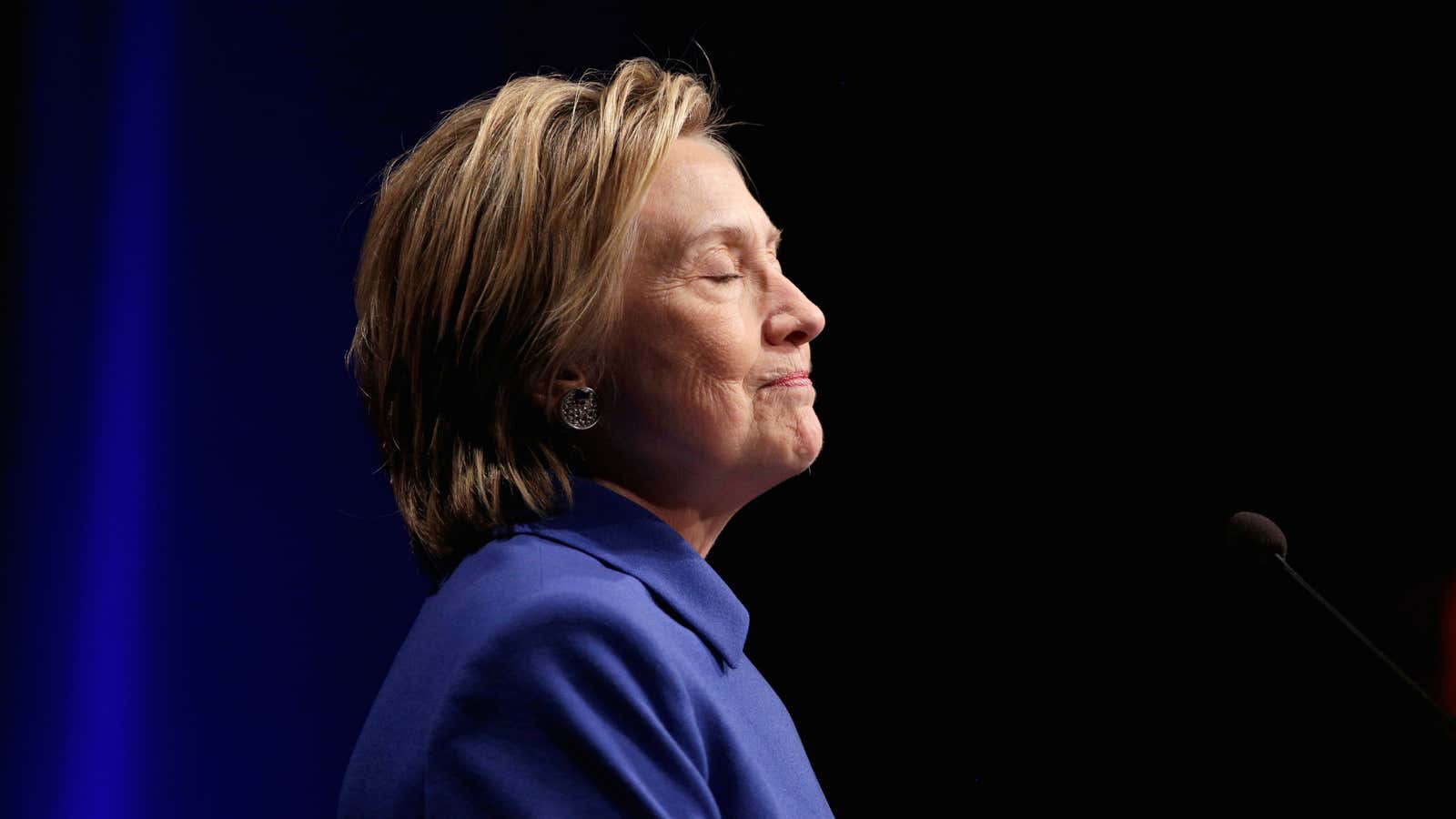In the weeks since America elected Donald Trump president, the businessman turned president-elect has largely dominated the news cycle. But his former opponent hasn’t completely receded from the national spotlight. A day after her concession speech, Hillary Clinton was spotted hiking in the woods of upstate New York. Not long after, a supporter connected with her in a Rhode Island bookstore. And there have been more formal appearances as well, like her November 16 speech at a Children’s Defense Fund event. All of these Clinton post-election sightings, though different in circumstance, are connected by a single, important thread. In a sharp break from her decades on the national stage, Clinton is no longer wearing visible makeup.
For women in the public eye, makeup is never really “just makeup”—and few are as intimately aware of this fact as Hillary Rodham Clinton. Back in October, the New York Times offered an extended look at “How Hillary Became ‘Hillary,’” profiling the choices made by Clinton as she adapted to life in the public eye. Among the piece’s more telling insights was the revelation that, prior to her husband’s 1982 comeback in the Arkansas governor’s race, Clinton did not regularly wear makeup. Her revamped beauty routine—one of many sacrifices she would make for her husband over the years—was part of a concerted strategy to convince traditional Arkansas voters that Clinton was the type of first lady the state could truly get behind. For Clinton, there’s an inextricable relationship between embracing cosmetics and being the kind of woman America feels comfortable watching on a national stage: as first lady, as a senator, as secretary of state, and, most recently, as a presidential candidate.
Throughout her career, Clinton’s cosmetic routine has been subjected to debate. Though her makeup was what made her an acceptable first lady, as she moved into a political career of her own, her use of cosmetics has been used to discredit and even attack her. During the 2008 primary, a (male) Washington Post columnist mused that her adherence to beauty standards took time out of her day and put her at a disadvantage against her male opponents. A few days before the 2016 election, a Glamour writer revealed that her husband had argued Clinton’s “obsession” with physical appearances indicated she’d be a poor fit for the presidency.
Yet it’s hard to imagine Clinton would have been celebrated or rewarded for rejecting society’s standards for female appearance. Bernie Sanders may get kudos for not giving a hoot about what he looks like, but—as the man who defeated Clinton this past November has made perfectly clear—women who don’t fit a very narrow definition of attractiveness can get called slobs, pigs, or something even worse.
And yet, even if Clinton’s beauty routine was never exactly optional, over the years she learned to wield it as a weapon, turning the burden of beauty culture into a strategic tool (if not an outright advantage). During the weeks leading up to the presidential election this November, the media thrilled at the sight of Clinton using her sartorial choices to communicate patriotism, a dedication to women’s rights, and, of course, the historic nature of her own achievements. However boxed in Clinton may have been by beauty culture, she managed to make it her own, demonstrating that beauty and power need not be mutually exclusive—and that the supposed frivolity of fashion could be its own sort of aggressive power stance.
And so on one level, seeing Clinton sans makeup feels a bit sad, like an admission that her political career has come to an end. Gone is the carefully crafted visage, the cosmetics-as-war-paint armor of a woman determined to do battle for her country. In its place is a vulnerable, unguarded woman, the “flawed candidate” the media spent months dissecting.
But there’s also something freeing—and maybe even hopeful—about Clinton’s decision to go barefaced. For almost 40 years, Clinton’s been forced to walk a very thin line: to be powerful yet feminine, beautiful yet not self-obsessed, maternal yet still able to make time for the needs of the nation. Makeup has always been a way to signal that, whatever calculating, ambitious qualities she may possess, she’s still just a mother and grandmother at heart, someone you could just as easily bake cookies with as discuss national security.
With her face unpainted, it’s almost as if Clinton is returning to an earlier iteration, reclaiming her identity as the accomplished, aggressive lawyer Hillary Rodham, who pursued success while rejecting the rules put forth by the patriarchy. And why not? For the past three decades, Clinton played by those rules with dedication and aplomb, and she still couldn’t break that highest, hardest glass ceiling. Perhaps it’s time to throw out the rulebook and start again, beginning with the conviction that women, like men, are—more than madonnas or whores or angels or sluts or any of the other categories we routinely box half the population into. If there’s any silver lining to this election mess, it’s that after 40 years of scrutiny and stricture, Hillary Clinton is finally, triumphantly, human again.




